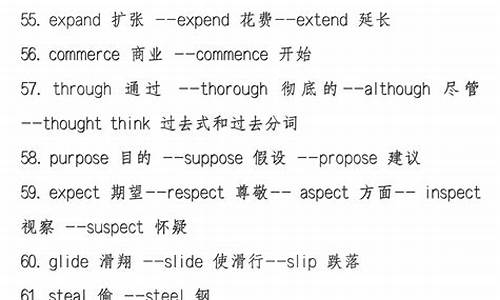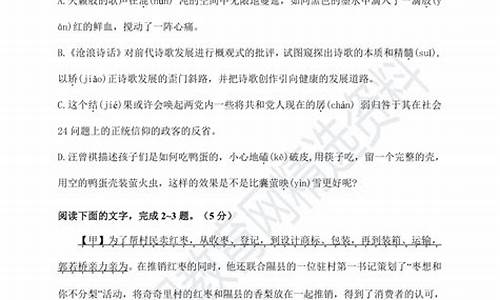您现在的位置是: 首页 > 教育比较 教育比较
高考形似动词,动词て形いて
tamoadmin 2024-06-10 人已围观
简介1.高考复习英语常用动词短语有总的归纳吗?2.高考英语语法填空题型超实用解题技巧3.托业考试高频词汇总结:动词4.高考英语语法:高考英语总复习语法专项 情态动词5.语文中的情态词是什么6.高考英语语法: 接不定式和动名词含义相同的动词高考英语语法:表示“变化”连系动词的用法 英语中表示“变化”的连系动词主要有 become, come, go, get, grow, turn等。使用时注意以下几
1.高考复习英语常用动词短语有总的归纳吗?
2.高考英语语法填空题型超实用解题技巧
3.托业考试高频词汇总结:动词
4.高考英语语法:高考英语总复习语法专项 情态动词
5.语文中的情态词是什么
6.高考英语语法: 接不定式和动名词含义相同的动词

高考英语语法:表示“变化”连系动词的用法
英语中表示“变化”的连系动词主要有 become, come, go, get, grow, turn等。使用时注意以下几点:
一、become 和get的用法
主要指一个人暂时性的身心变化或永久性的自然变化。如:
Hearing this, the boss became [got] angry. 听到这事,老板就生气。
The travelers became [got] thirsty. 旅客们渴了。
Soon the man became famous. 不久后这个人就出名了。
If you eat such food you’ll get [become] fat. 如果你吃那样的食物,你会发胖的。
另外,还有become [get] ill, old, well, deaf, strong, etc (得病,变老,痊愈,变聋,变强,等)。
另外,become 和 get 还可用于指天气的变化和社会的趋势。如:
It’s becoming [getting] cold (dark, cloudy). 天渐冷了(黑了,多云了)。
Divorce is becoming [getting] more common. 离婚现象越来越常见了。
This design of resident buildings is becoming [getting] fashionable. 这种住宅楼的设计正在逐渐流行起来。
二、go 和come 的用法
两者均可表示变化,但前者主要指一种由强到弱或由好到坏的变化(可用于人或事物),后者则主要指向好的方面变化。如:
go bald (deaf, insane, etc) 发秃,变聋,发疯,等
The meat’s gone off [gone bad]. 肉变味(变坏)了。
The radio’s gone wrong. 收音机出毛病了。
Her wish came true. 她的愿望实现了。
Everything came right. 一切顺利。
另外,go还可用于人或事物颜色的变色,与turn用法相同。如:
She went [turned] blue with cold. 她冻得脸色发青了。
The rotten meat went [turned] green. 这块腐烂的肉变绿了。
说明:
1. go 一般不与 old, tired, ill 等连用,遇此情况要用其他连系动词。如:
grow [get] old 变老 fall [become] ill 生病
fall [become] sick 生病 get [feel] tired 疲劳
2. go后接形容词通常表示结果(见上例),但在个别搭配中也可表示状态。如:
go hungry 挨饿 go naked 光着身子
3. come 除表示向好的方面变化外,还有以下常见搭配值得注意。如:
come untied 解开 come loose 变松 come undone 松开
三、grow 的用法
grow 主要表示逐渐变化,强调变化的过程。如:
It began to grow dark. 天色渐渐黑了。
Bob is growing old. 鲍勃渐渐变老了。
The sea is growing calm. 大海变得平静起来。
The pollution problem is growing serious. 污染问题日趋严峻。
四、关于结构
以上提到的连系动词通常接形容词作表语,但有的还可接其他结构,如come, get, grow后可接不定式,become, turn后可接名词,go, get, grow后可接介词短语。如:
You’ll soon grow to like her. 你很快就会喜欢她的。
Soon I came to like him. 不久我便开始喜欢他了。
It’s becoming a serious problem.它正在成为一个严重问题。
The little plant grew into a tree. 幼苗长成了一棵树。
They went out of fashion years ago.它们好多年前已变得不时新了。
说明:turn后接名词时,往往表示意想不到的变化,名词前通常用零冠词。如:
He turned writer after he graduated from a medical college. 他从医学院毕业后当了作家。(比较:He became a writer after graduating from college.)
高考复习英语常用动词短语有总的归纳吗?
高考必考十种时态英语是一般现在时、一般过去时、一般将来时、过去将来时、现在进行时、过去进行时、 将来进行时、现在完成时、过去完成时、现在完成进行时、将来完成时。
一般现在时
1、概念:经常、反复发生的动作或行为及现在的某种状况。
2、时间状语: always, usually, often, sometimes, every week (day, year month...), once a week, on Sundays,
3、基本结构:动词 原形(如主语为第三人称单数,动词上要改为第三人称单数形式)
4、否定形式:am/is/are+not;此时态的谓语动词若为行为动词,则在其前加don't,如主语为第三人称单数,则用doesn't,同时还原行为动词。
5、一般疑问句:把be动词放干句首:用助动词do提问,如主语为第三人称单数,则用does,同
时,还原行为动词。
6、例句:It seldom snows here.
He is always ready to help others
Action speaks louder than words.
二、一般过去时:
1、概念:过去某个时间里发生的动作或状态;过去习惯性、经常性的动作、行为。
2、时间状语:ago, yesterday, the day before yesterday, last week,last(year night month.….) just now, at the age of 5, one day, long long ago, once upon a time, etc.
3、基本结构:be动词;行为动词 的过去式
4.否定形式:was/were+not;在行为动词前加didn't,同时还原行为动词。
5、一般疑问句:was或were放于句首:用助动词do的过去式did 提问,同时还原行为动词。
6、例句:She often came to help us in those days。
I didn't know you were so busy。
高考英语语法填空题型超实用解题技巧
l.动词+about\x0d\ speak/talk about 谈论 think about 思考\x0d\ care about 关心,对?有兴趣 bring about 引起,使发生\x0d\ set about 着手,开始 come about 发生\x0d\ hear about 听说 worry about 为?担心\x0d\2.动词+away\x0d\ throw away 扔掉 blow away 吹走\x0d\ carry away 拿走,使入迷 clear away 清除掉,消散\x0d\ die away 逐渐消失,减弱 pass away 去世\x0d\ wash away 冲走 take away 拿走,使消失\x0d\ put away 收拾起来,存起来 give away 背弃,泄漏,赠送\x0d\ wear away 磨掉,消耗 break away 摆脱\x0d\ send away 让走开 turn away 把?打发走\x0d\3.动词+back\x0d\ keep back 隐瞒,忍住 look back(on) 回顾\x0d\ hold back 控制住 give back 归还\x0d\ call back 回电话 take back 拿回,收回\x0d\4.动词+for \x0d\ run for 竞选 ask for 要求得到\x0d\ wait for 等候 stand for 代表,表示\x0d\ long for 渴望 hope/wish for 希望得到\x0d\ care for 关心,喜欢 beg for 乞求\x0d\ search for 查找 look for 寻找\x0d\ call for 需要,要求 hunt for 寻找\x0d\ change?for 用?换 charge?for 收费,要价\x0d\ apply for 申请 take?for 误以为?是\x0d\ seek for 寻找 come for 来拿,来取5.动词+down\x0d\ burn down 烧毁 break down 坏了,垮了,分解\x0d\ take down 记下,记录 turn down 调小,拒绝\x0d\ cut down 削减,砍倒 slow down 慢下来\x0d\ pass down 传下来 put down 记下,写下,镇压\x0d\ calm down 平静下来 bring down 使?降低,使倒下\x0d\ settle down 安家 come down 下落,传下\x0d\ tear down 拆毁,拆除\x0d\6.动词+at\x0d\ come at 向?袭击 shout at 冲(某人)嚷嚷\x0d\ run at 冲向,向?攻击 work at 干?活动(研究)\x0d\ tear at 用力撕 look at 看,注视\x0d\ stare at 凝视 glare at 怒视\x0d\ glance at 匆匆一瞥 laugh at 嘲笑\x0d\ knock at 敲(门、窗等) point at 指向\x0d\ smile at 冲(某人)笑 strike at 向?打击\x0d\ aim at 向?瞄准 shoot at 向?射击\x0d\ wonder at 惊讶 call at 拜访(地点)\x0d\7.动词+from\x0d\ differ from 与?不同 suffer from 受?苦\x0d\ hear from 收到?来信 die from 因?而死\x0d\ keep/stop/prevent?from阻止? learn from 向?学习 \x0d\ result from 由于 date from 始于?时期 \x0d\ separate?from 把?分离开 \x0d\8.动词+of\x0d\ think of 想到 dream of 梦到\x0d\ consist of 由?组成 speak of 谈到\x0d\ approve of 赞成 die of 死于\x0d\ talk of 谈到 hear of 听说\x0d\ complain of 抱怨 become of 发生?情况,怎么啦\x0d\9.动词+off\x0d\ start off 出发 set off 出发\x0d\ leave off 中断 show off 炫耀\x0d\ get off 下车 take off 脱下,起飞\x0d\ see off 送行 ring off 挂断电话\x0d\ put off 延期,推迟 come off 脱落,褪色\x0d\ cut off 切断,断绝 fall off 跌落,掉下\x0d\ keep off 避开,勿走近 go off 消失;坏了,爆炸,不喜欢\x0d\ knock?off 把?撞落 break off 打断\x0d\ pay off 还清 carry off 携走带走,赢得\x0d\ get off 脱下(衣服等) give off 散发出\x0d\ turn(switch) off 关掉\x0d\10.动词+on\x0d\ depend on 依靠 rely on 依靠\x0d\ insist on 坚持 carry on 继续,进行\x0d\ keep/go on 继续 spend?on 在?花钱\x0d\ put on 穿上,戴上,上演 call on 拜访\x0d\ move on 继续移动,往前走 live on 以?为生\x0d\ feed on 以?为生 bring on 使?发展\x0d\ take on 雇用,呈现(新面貌等) try on 试穿\x0d\ have on 穿着 pass on 传授,传递\x0d\ look on 旁观 turn(switch) on 打开\x0d\11.动词+out\x0d\ break out 爆发 point out 指出\x0d\ pick out 选出 figure out 算出,理解\x0d\ burst out 进发 bring out 阐明,使表现出\x0d\ carry out 执行,进行 help out 救助\x0d\ hold out 坚持下去 set out 出发,着手,摆放\x0d\ wear out 穿破,使?疲劳 turn out 结果是,生产,培养\x0d\ make out 理解,看清楚 come out 出版,出来\x0d\ cross out 划掉 leave out 省略,删掉\x0d\ keep out(of) 使不进入,挡住 work out 算出,想出办法等\x0d\ find out 查出,弄明白 give out 散发,分发,用完\x0d\ try out 试用,试验 look out 当心,提防\x0d\ put out 扑灭 speak out 大胆讲出\x0d\ hand out 散发 send out 发出,派遣\x0d\ run out 用完 go out 熄灭\x0d\ let out 泄漏,发出(声音),出租 die out 灭绝\x0d\12.动词十in\x0d\ give in 让步 hand in 上交\x0d\ bring in 引进,使得到收入 drop in 拜访\x0d\result in 导致 succeed in 在?获成功\x0d\ join in 参加 take in 接纳,吸收,改小\x0d\ get in 收获,进入 break in 强制进入,插话\x0d\ fill in 填写 call in 召集,来访\x0d\ cut in 插入 persist in 坚持\x0d\ look in 来访,参观\x0d\13.动词十into\x0d\ look into 研究,调查 turn into 变成\x0d\ burst into 闯入,进发 divide?into 把?分成\x0d\ change?into 把?变成 put/translate?into 把?译成\x0d\ run into碰到 send sb to/into sleep 使进入状态\x0d\14.动词+over\x0d\ turn over 翻倒,细想 think over 仔细考虑\x0d\ go over 审阅,检查,研究 look over 翻阅,检查\x0d\ get over 克服 run over 压死,看一遍\x0d\ take over 接管,接替 watch over 看守,照看\x0d\ fall over 跌倒,摔倒 roll over 翻滚\x0d\15.动词十to\x0d\ belong to 属于 object to 反对\x0d\ refer to 谈到,涉及,参阅 point to 指向\x0d\ turn to 向?求助,查阅 stick/hold/keep to 坚持,忠于\x0d\ see to 处理,料理 come to 共计,苏醒\x0d\ reply to 答复 get to 到达\x0d\ bring to 使苏醒把?比作 compare?to 与?相比;把?比作\x0d\ agree to 同意 write to 写信给\x0d\ supply?to 为?提供 lead to 导致,通向\x0d\ add to 增添 attend to 处理,专心,照料\x0d\ devote?to 贡献给\x0d\16.动词+up\x0d\ grow up 成长,长大 give up 放弃,献出\x0d\ build up 建立 set up 架起、建立\x0d\ put up 搭起,架起,安装,住宿,张贴,盖起\x0d\ do up 整理,包装,打扮 \x0d\ go up 增长,上涨get up 起床,站起 \x0d\ pick up 拾起,学会,用车,来接,收听到\x0d\ bring up 抚养,呕吐,提出 出现\x0d\ turn up 开大(音量等),出席\x0d\ stay up 挺住,熬夜\x0d\ take up 开始学,从事,占据\x0d\sit up 熬夜 eat up 吃完\x0d\ use up 用完 tear up 撕碎\x0d\ lay up 储存 make up构成,组成 编造 弥补\x0d\ cut up 切碎 join up 联结起来,参军\x0d\ end up 总结 come up 上来,长出,出现\x0d\ speed up 加快速度 throw up 呕吐\x0d\ clear up 整理,收拾,放晴 look up 查找,找出\x0d\ bum up 烧毁 catch up 赶上\x0d\ hurry up 赶快 fix up 修理,安排,装置\x0d\ keep up 保持 hold up 耽搁,使停顿\x0d\ send up 发射 ring up 打电话\x0d\ open up 开创,开辟 divide up 分配\x0d\ break up 分解\x0d\17.动词十through\x0d\ get through 通过,干完,接通电话 \x0d\ look through 翻阅,看一遍,仔细查看\x0d\ go through 审阅,检查,学习 \x0d\ put?through 接通电话 see through 识破 \x0d\ check through 核对 pull through 渡过危机,康复\x0d\18.动词+with\x0d\ deal with 处理,对付 do with 处理,需要\x0d\ meet with 遇到,遭受 talk with 同?交谈\x0d\ agree with 同意,与?一致 compare with 与?相比\x0d\ combine with 与?相联合 equip?with 以?装备\x0d\ cover?with 用?覆盖 begin with 以?开始\x0d\ end up with 以?结束 supply?with 以?供给\x0d\ provide?with 以?供给 play with 玩,玩弄\x0d\19.三词以上的短语动词\x0d\ add up to 总计 break away from 摆脱\x0d\ keep away from 避开,别靠近 do away with 废除\x0d\ look down on 轻视 look up to 仰望,尊敬\x0d\ put up with 忍受 catch up with 赶上\x0d\ keep up with 赶上 run out of 用完\x0d\ make up for 弥补 go on with 继续\x0d\ get on(along) with 和?相处 look forward to 盼望\x0d\ get close to 接近 take hold of 握住\x0d\ get out of 逃避,避免 get down to 认真开始\x0d\ set fire to 放火烧 pay attention to 注意\x0d\ take notice of 注意 set an example to 为?榜样\x0d\ do well in 在?干得好 pay a visit to 访问\x0d\take a photo of 拍?照片 take the place of 取代
托业考试高频词汇总结:动词
高考英语语法填空可是近年来高考英语的热捧的一种新型题型,下面我跟大家说说高考英语语法填空解题技巧,希望对你有帮助。
高考英语语法填空已给单词提示题型的技巧
已给单词提示题型,这种题型多是考察学生对单词的掌握程度。因为已给提示,所以只会在单词形式变化上下文章,一种是简单的形式变化,例如单复数,时态变化,再有就是词类派生的变化,这种就需要联系整个句子或者是文章来填写了。
我推荐: 高考英语作文必背万能开头句型模板
技巧一:名词形式变化。
高考英语语法填空题名词的形式变化主要有单数、复数、所有格的变化。这是最简单也是最基本的形式变化,只要注意整体形式的一致性。
技巧二:动词形式变化。
高考英语语法填空题动词的形式变化比较多,有谓语的变化(时态、语态、语气),有非谓语的变化(不定式、动名词、现在分词、过去分词)。这种动词形式的变化,一定要注意个别的变化异样,这种最容易犯错。
技巧三:代词形式变化。
高考英语语法填空题代词形式变化通常是与人称变化有关的三大类五小类,即人称代词(主格和宾格)、物主代词(形容词性和名词性)、反身代词。另外还有几个不定代词的形式变化,如no one/none、other/another等。这种需要联系句意或者文章,整体把握。
技 巧四:形容词、副词比较级变化。
英语中大部分形容词和表方式的副词都有原级、比较级和最高级的变化。构成比较级和最高级的方式,或通过加后缀一er和.est,或在词前Imore/less和most/least,且形容词的最高级还要冠以the。
技巧五:数词形式变化。
高考英语语法填空题数词的形式变化包括基数词、序数词,或加后缀一teen、ty的变化,甚至还有作分母用的序数词的单复数形式,以及one/two的特殊变化形式once/twice。这种数词形式变化则是需要整体理解的,尤其要注意细节。
技巧六:词的派生。
高考英语语法填空题词的派生现象在英语单词中是较为普遍的,派生现象主要发生在名词、动词、形容词、副词四种词中。这种题型还有可能检测学生对词根、前后缀、派生词的掌握。而很多单词的派生不同意思也会有区别,一定要注意,不是所有前后缀都遵循一个规律,会有个别例外,而特别的一定要重点记住的。
做高考英语语法填空题语境背景要弄清有些高考英语语法填空题常常在语境中考查考生对语言结构和语言知识的考查,这类高考英语语法填空题型是近年来常考题。这就要求考生要针对语境做细致的分析,以高考英语语法填空题的语境为切入点对测试题进行思考,分析,甄别和抉择。
高考英语语法:高考英语总复习语法专项 情态动词
相信备考托业的大家都很清楚词汇量的重要,为了帮助大家备考,下面我给大家带来托业考试高频词汇 总结 :动词,希望喜欢!
托业考试高频词汇总结:动词1
1 strand 使搁浅,陷入困境
2 relate 叙述
3 facilitate 使便利
4 excel 优出胜出 ~ in 名词 excellence
5 exceed 超过
6 remit 汇款,宽恕
7 highlight 强调
8 inoculate 接种
9 vaccinate 接种疫苗
10 remedy 补救
托业考试高频词汇总结:动词2
11 undermine 诋毁
12 reverse 颠倒 ~ the verdict 判决
13 slam 使劲关 ~ dunk
14 equip 配备
15 capsize 倾覆(船)
16 simmer 炖,煨
17 retrench 减少,节约
18 discredit 使失去性,破坏名誉的
19 curb 阻止,控制 ~ the use of marijuana
20 process 加工
托业考试高频词汇总结:动词3
21intercept 中途拦截
22 segregate 隔离,分开分离
23 quarantine 隔离检疫
24 seclude 隔绝,隐退,隐秘
25 appeal 呼吁,恳求,上诉
26 lift 解除,提起精神
27 rescind 废止,取消
28 audit 查帐
29 condemn 非难,判罪
30 condone 宽恕,容忍
托业考试高频词汇总结:动词4
31 deviate 偏离,跑题 ~ from
32 disabuse 解惑,矫正
33 disavow 否认
34 transfuse 输血
35 mingle 交往,混合
36 forfeit 没收 confiscate
37 staple 用订书器钉 ADJ 主要的重要的
38 deregulate 解除对---的管制
39 block 阻挡N 楼
40 launch 推出新产品,实施 (an investigation into the scandal)
托业考试高频词汇总结:动词5
41 house V. 为---提供住房
42 expel 开除,驱除
43 reimburse 报销,伏款 = refund
44 observe 遵守 ~ the smoking rule
45 syndicate (在报刊,杂志联盟)多家报刊上同时发表
46 commute 通勤
47 rotate 旋转,循环
48 implement 实行
49 liquidate 清算,清偿债务
50 accrue 增长,自然增殖
托业考试高频词汇总结:动词相关 文章 :
1. 高中英语十大高频动词词组汇总
2. 常用英语动词短语总结
3. 高考英语动词的知识点总结
4. 初中英语动词的知识点总结
5. 非谓语动词用法总结大全
6. 英语知识
7. 托业英语重点记忆单词汇总
8. 动词make的用法总结
9. 托业考试复习方法攻略
10. 常用英语词汇
语文中的情态词是什么
《高考英语总复习语法专项 情态动词》由留学英语组我整理(www.liuxue86.com)。本内容整理时间为05月12日,如有任何问题请联系我们。
高考英语总复习语法专项 情态动词
2009-03-18 11:48 来源:互联网 作者:佚名 [打印] [评论]
情态动词有一定的词义, 表示某种感情或语气, 是不完全动词, 不能单独作谓语, 需和实义动词一起构成谓语. 常见的情态动词有: can / could, may / might, must, shall / should, will / would, need, ought to, dare / dared等
一.may / might的用法:
1.表示?可以?, 即表示说话人许可或请求许可
a. You may take it away.
b. May I come in ?
2.表示?可能, 也许? (在疑问句中通常不用may / might, 而用likely, do you think, can等表示?是否可能, 会不会?的意思)
a. He may come today.
b. Is it likely to rain ?
c. Do you think the train will be late ?
d. Can the news be true ?这消息会是真的吗?
3.在提建议时, 可用May I
a. May I carry your bag ?
b. May I make a suggestion ?
二.can / could的用法:
1.表示许可或请求许可, 相当于may. 但can比may用得更广泛. can不仅表示说话人同意, 准许, 还可以表示客观条件许可. may通常只表示说话人同意或准许
a. The class is over. You can go home now.
b. You can go there tomorrow.
c. Can I borrow your car for today ?
2.在提建议时, 可用Can I / you
a. Can I buy you a drink ?
3.表示?会, 能?, 相当于be able to
a. He can speak English.
b. Can you play tennis ?
c. Little Tom can?t move the big box.
4.在疑问句中表示怀疑, 不确定或不会有的情况, 即?否定的推测?
a. Can it be true ? 这是真的吗?
b. Can it be true that he has passed the exam ? 他真的通过考试了吗?
5.can?t / couldn?t在陈述句中可表示?肯定不, 一定不?的意思
a. He can?t be in the room right now.
b. It can?t have rained last night, for the ground is dry.
6.can?t / couldn?t help doing sth表示?不得不,忍不住做某事?
a. People couldn?t help laughing at the foolish emperor.
7.can / be able to do的区别:
①.be able to可用于各种时态, 而can只有现在时can和过去时could
②.be able to可以和另一个不完全动词连用, 如should be able to (应该能够), must be able to (必须能够)等, 而can则不可以这样用
③.强调?能力?时, 多用be able to
a. The patient was soon able to sit up and read.
④.can可用于人或其他事物作主语的句子中; be able to只用于有生命的名词或代词作主语的句子中
三.must的用法:
1.表示?必须?, 它的否定形式是need not / needn?t, 而不是must not / mustn?t, mustn?t表示禁止或不许做某事
a. You must set off at once.
b. You needn?t tell John about it.
c. You mustn?t play with fire.
2.表示?肯定是, 一定是?的推测意义; 与此对应, 表示?肯定不,一定不?用can?t, 而不用mustn?t
a. You must be very tired now.
b. If he had really been there, I must have seen him.
c. He must have gone away. We don?t see him anywhere.
3.must / have to的区别:
①.must / have to一般可以通用, 但must侧重于说话人主观上的看法, 即?说话人认为必须?; have to侧重于客观上的需要, 含有?客观上不得不?之意
a. If the person is not breathing, you must try to start his breathing.
b. You must / have to study with a teacher if you want to know how to do first aid.
②.must没有时态的变化, 一般用于表示现在或将来; have to有时态的变化, 可用于过去, 现在, 将来各种时态
a. We must study hard when we are young.
b. I think she must remain in hospital for a week.
c. We had to stay there for a whole day because of the rain.
d. We have to practise a lot if we want to speak English well.
e. The situation has changed; we will have to change our plan.
③.它们的否定式mustn?t / not have to有很大的不同: mustn?t表示?不要(做某事)?, 有禁止之意; not have to表示?不必要(做某事)?, 含有?客观上无此必要?之意
a. You mustn?t move a person if he is badly hurt.
b. You don?t have to be a doctor to do first aid.
四.would的用法:
1.表示主观意志和愿望, 即?愿意,想要?
a. Come here whenever you would.
b. He would not leave before he finished his work.
2.would do sth可以表示过去经常发生的动作, 相当于used to do sth
a. When we were children we would go swimming every summer.
b. On Sundays he would go fishing for hours when he lived in the countryside.
3.表示请求, 愿望, 语气客气, 委婉
a. I would like some tea.
b. Would you mind closing the door ?
c. Would you tell me something about your trip ?
4.表示推测, 表示?大概, 也许?的意思
a. That would be the pen you are looking for.那也许是你在找的笔吧
五.should的用法:
1.表示义务, 责任, 可译为?应当?
a. We should complete the text in time.
b. You should be so careless.
2.表示推测或推论, 可译为?可能, 应该是?
a. He should be home by now, I think.
b. He should have arrived in Nanjing by this time.
3.should / ought to的区别:
should / ought to一般可以通用. should侧重于说话人主观上的看法, 有时含有劝告, 建议的口气, 即 ?按我的想法应该如何?; ought to语气更强, 强调?有责任, 有义务做某事?或者 ?按道理应该如何?
a. ?I will start the work at once. I think you should start at once.?
b. ?I will start the work tomorrow. No. You ought to start at once.?
六.need的用法: need表示?需要?, 既可作为情态动词, 也可作实义动词
1.need作实义动词时, 注意以下用法:
①.need to do sth; ②.need sb to do sth; ③.need doing sth (主动形式表被动意义)
a. You need to remain in bed.
b. I need you to help me with the housework.
c. The garden needs watering.( =The garden needs to be watered.)
2.need作情态动词时, 多用于否定句及疑问句中, 不用于肯定句中
a. It is still early. You needn?t hurry. =You don?t need to hurry.
b. It is 11 o?clock. Need I go now? =Do I need to go now ?
3.对于用need的提问, 肯定回答用must, 否定回答用needn?t
a. Need I come? Yes, you must. / No, you needn?t.
七.dare / dared的用法: 表示 ?敢?, 既可作为情态动词, 也可作为实义动词
1.作为情态动词时, 主要用于否定句和疑问句中, 不用于肯定句中
a. Little Jane dared not go alone. =Little Jane didn?t dare to go alone.
b. Dare you go out alone at night ? =Did you dare to go out alone at night ?
2.作为实义动词时, 可用于: dare to do sth
a. Little Jane didn?t dare to go alone.
b. Did you dare to go out alone at night ?
3.should / ought to的区别:
should / ought to一般可以通用. should侧重于说话人主观上的看法, 有时含有劝告, 建议的口气, 即 ?按我的想法应该如何?; ought to语气更强, 强调?有责任, 有义务做某事?或者 ?按道理应该如何?
a. ?I will start the work at once. I think you should start at once.?
b. ?I will start the work tomorrow. No. You ought to start at once.?
六.need的用法: need表示?需要?, 既可作为情态动词, 也可作实义动词
1.need作实义动词时, 注意以下用法:
①.need to do sth; ②.need sb to do sth; ③.need doing sth (主动形式表被动意义)
a. You need to remain in bed.
b. I need you to help me with the housework.
c. The garden needs watering.( =The garden needs to be watered.)
2.need作情态动词时, 多用于否定句及疑问句中, 不用于肯定句中
a. It is still early. You needn?t hurry. =You don?t need to hurry.
b. It is 11 o?clock. Need I go now? =Do I need to go now ?
3.对于用need的提问, 肯定回答用must, 否定回答用needn?t
a. Need I come? Yes, you must. / No, you needn?t.
七.dare / dared的用法: 表示 ?敢?, 既可作为情态动词, 也可作为实义动词
1.作为情态动词时, 主要用于否定句和疑问句中, 不用于肯定句中
a. Little Jane dared not go alone. =Little Jane didn?t dare to go alone.
b. Dare you go out alone at night ? =Did you dare to go out alone at night ?
2.作为实义动词时, 可用于: dare to do sth
a. Little Jane didn?t dare to go alone.
b. Did you dare to go out alone at night ? 《高考英语总复习语法专项 情态动词》由留学英语组我整理(www.liuxue86.com)
高考英语语法: 接不定式和动名词含义相同的动词
情态动词表示主语做某动作的可能,意愿,必要,也称为能愿动词。其包括能/能够(can)、会(can/will)、该/应该/应当(should)、配/值、宁可等。
其特点是以实义动词作为补语。应当注意不同语言的情态动词没有严格的一一对应关系。有些在汉语中是“情态动词+动词”的表达在其他语言里是“实义动词+动名词作宾语”。
现代汉语的情态动词有:能、能够、可以、会、可能、敢、肯、愿意、情愿、乐意、想、要、应、应该、应当、该、值得、配、好、一定、必须。
扩展资料:
用“情态动词+have +done”结构表示对过去动作的推测,高考试题中常用过去时态或过去的时间状语给以暗示。情态动词的这一用法可以用 “对立统一”来概括。
1、当试题的前句和后句在动作和意义上相互补充说明,且整个句意在动作和时间上是一个整体时,我们可用“统一”关系来解决这样的试题。常见的结构有:
must have done: 表示对过去动作的肯定推测,常译作“一定做了……”,只能用于肯定句中。其否定形式为can't/couldn't have done 疑问式为Can/Could...have done?。
could /might have done:表示对过去发生的动作的可能性推测,常译作“可能做了……”
2、当试题的前后句在动作和意义上构成转折关系时,常借助“but, however, instead”等词来表示过去的动作与客观事实不符,这时我们就可以用“对立”关系来解决这样的试题。
这种结构常见的有:
should have done / ought to have done:表示过去本应该做某事而实际上没有做。
should not have done / ought not to have done:表示过去本不应该做某事但事实上却做了
need have done:表示过去本来有必要去做某事,但事实上没有做。
need not have done:表示过去本来没有必要做某事,但事实上却做了。
百度百科-动词
人民网-注意语境和句子间差别 高考情态动词用法
高考英语语法:接不定式和动名词含义相同的动词
这类动词主要有like(喜欢),love(喜欢),hate(憎恨),prefer(宁可),begin(开始),start(开始),continue(继续),can’t bear(不能忍受),bother(麻烦),intend(想要),attempt(试图),cease(停止)等。如:
He likes to sing [singing]. 他喜欢唱歌。
It has started to rain [raining]. 开始下雨了。
You needn’t bother to come up [coming up]. 你不必费心来了。
The baby continued to cry [crying] all night. 这孩子哭了一整夜。
几点说明
(1) 当 like, love, hate, prefer 与 would, should 连用时,其后只能接不定式。如:
I’d like to tell you something. 我想告诉你一些情况。
I’d hate to spend Christmas alone. 我不喜欢一个人过圣诞节。
(2) 当 begin, start 本身为进行时态或后接 know, realize, understand 等静态动词时,其后的动词只能用不定式。如:
He was beginning to cook. 他开始做饭。
He started to realize that he was wrong. 他开始意识到自己错了。









